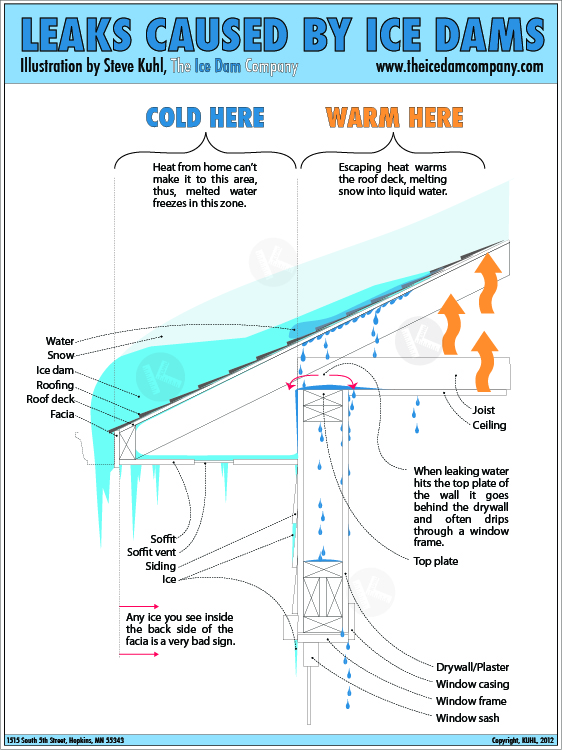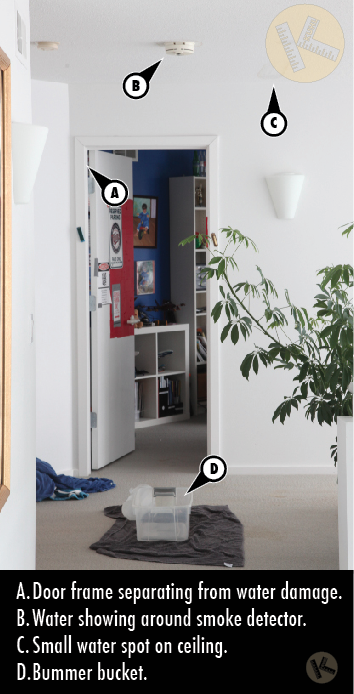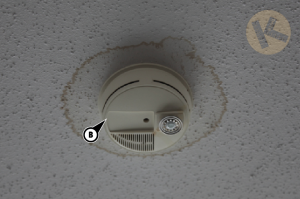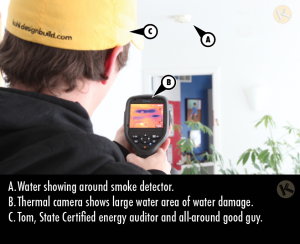4 Common Sources of Winter Roof Leaks
Friday, November 25th, 2016
How to Figure Out if the Leak is from Ice Dams or from Something Else?
As discussed in Ice Dam Company Case Study #03, ice dams can form in many locations on the typical home. The eave (lowest edge of the roof) is the most common area for ice dams but we find them around other areas including skylights, in valleys and in low-pitch roof pans and saddles. Many times a winter we get calls from concerned property owners who are experiencing leaks – or at least that is what appears to be happening – because they see water, moisture or discoloration on the ceiling. It’s logical, after all, to assume the roof is leaking when one sees that sort of thing. But the fact of the matter is that winter roof leaks can be attributed to a few potential sources. Here are a few of the common sources:
Plumbing Leaks
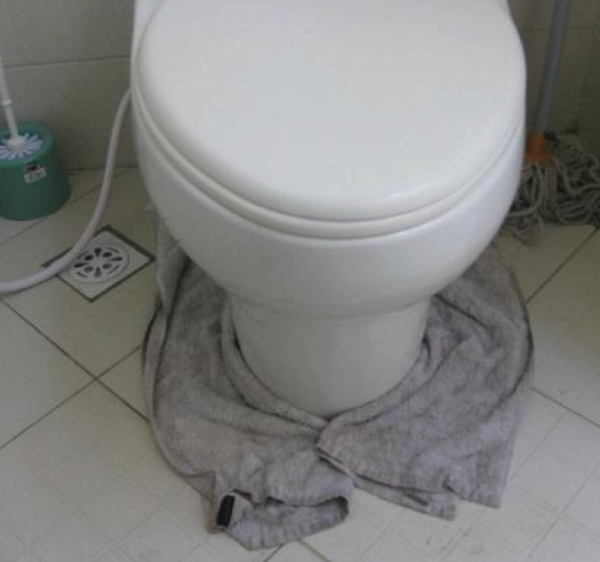
Is the leak in close proximity to a plumbing fixture, water supply or drain line? The most common sources of plumbing related leaks in homes are associated with failing shower pans, over-flowed bathtubs and faulty caulking or bad wax rings around toilets. Water can travel many feet from the source before it finds the path of least resistance and shows up. It’s typical to see water coming through penetrations through the ceiling such as recessed lights and at sheetrock seams many feet from the leak source. Plumbing failures can occur at any time during the year. When they happen in the winter, homeowners often assume its an ice dam. Plumbing leaks can be tricky to find and fix. Our favorite tool to find this type of leak is the thermal imager. This is a special camera that sees through walls and ceilings to detect differences in temperatures.
Attic Frost and Attic Condensation
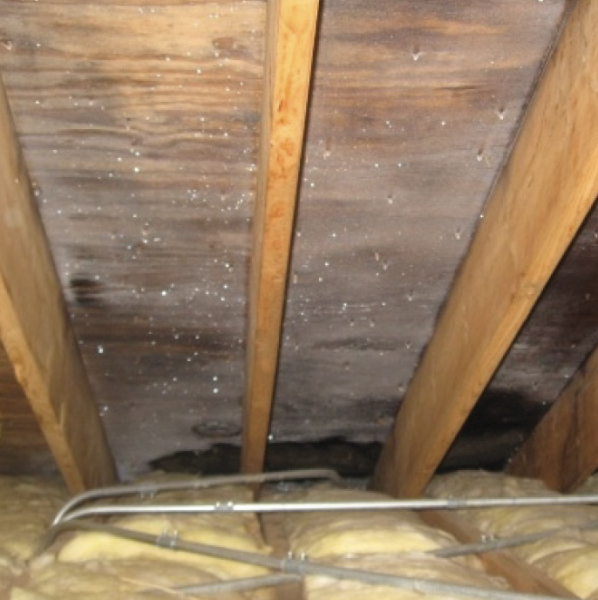
If possible, it can be tremendously helpful to peak into the attic. A healthy attic with good ventilation (Ice Dam Company Case Study #17) should not present moisture or frost on the framing members or roof decking. The photo, right, shows a poorly insulated, ventilated and air-sealed attic. Notice the frost on the underside of the roof decking? This is not good. Attic frost can cause tremendous damage and is most likely to accumulate when temps are quite low (below 10°F). Warm, moist air meets the ice-cold roof deck and freezes into frost. This cycle continues until as much as 1/8″ and 1/2″ of frost has built up. When outdoor temps rise above freezing, all of that frost melts and has nowhere else to go by the interior of the house. This type of ‘leak’ is tricky because it is actually not a leak. We have seen clients spend thousands of dollars trying to resolve a roof leak that was in fact nothing more than attic condensation. Future Ice Dam Company Case Studies will discuss how we fix this issue.
Exhaust Vent Condensation
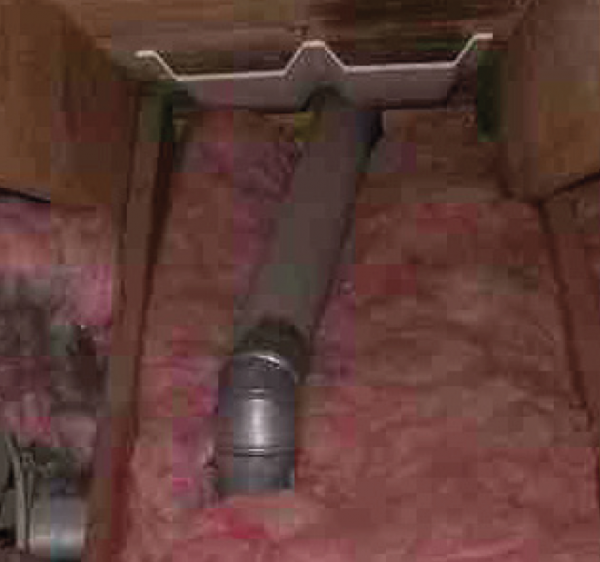
This is a very popular source of the winter roof ‘leak’ phone call we receive. Similar to attic frost-related leaks, this problem is related to the accumulation of frost inside an exhaust vent, commonly a bath vent duct where it travels through an unheated attic. A quick review of the temperature variations from the previous week is a good clue that we may be dealing with an exhaust vent condensation issue. If we had a number of days with extreme cold (highs in the single digits) followed by a thaw (highs in the mid-high 30’s) our first guess without even visiting the home is that the source of the moisture is a condensation issue, not a roof leak. Of course, a thorough site inspection is essential in confirming our suspicions. In almost all cases when exhaust vents are the culprit the leak shows up in the bathroom. Future Ice Dam Company Case Studies will discuss how we fix this issue.
Last but Not Least…Ice Dams
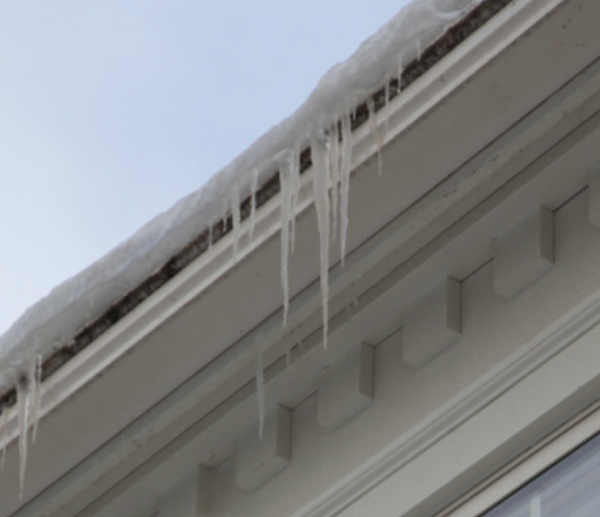
Do you see icicles on the eave near the leaking area? Do you see an ice dam? While not always the case, ice dam causing leaks are usually plainly visible from the ground (See Ice Dam Company Case Study #20). The steeper your roof pitch, the more ice it takes to create interior leaking (See Ice Dam Case Study #09). If you have a low-slope roof area, accumulations as little as 1″ thick can cause problems. Likewise, a heavy blanket of snow can hide the significance of an ice dam, making it hard to ascertain it’s size. Ice Dam Company Case Study #01 and #02 describe some easy things to look for in determining if you have an existing ice dam issue. In our experience, it is unusual to get roof leaks cause by ice dams when no appreciable ice accumulations can be seen from the ground. It can happen, however. It is common to see water/ice coming through the soffit or down the exterior wall when ice dams have developed to the point where they are forcing water to back up into the roofing system.
To read more Case Studies click here.






